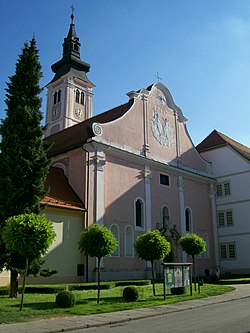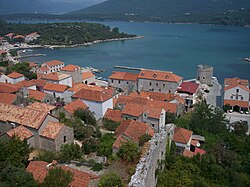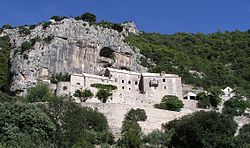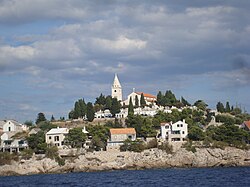 | Canto and two voice music in istriana scale |
| Good. immaterial registered in 2009.
|
On the peninsula of Istria, west of Croatia, the Croatian, isthrian and Italian communities continue to keep alive various forms of singing and music two voices on an island scale. This musical style is characterized by the power and slight nose of the voice. Although variations and improvisations are given in the two voices to a certain extent, the interpreters always end up singing in unison or with an octave of difference. The typical music instruments are the sopele caramills – always played in duo–, the gaitas, the flutes and the tambura lute. There are local style variants that have developed their own characteristics. For example, in the kanat, mostly interpreted by the Croatian population, the second voice is usually replaced or doubled with a small sopele. In another highly diffused variant, called tarankanje, words are sometimes replaced by characteristic syllables (ta-na, ta-ra-ran, etc.) to imitate the flute sound. This musical tradition is still very present in daily life and holidays, in particular weddings, religious ceremonies and community and family meetings. Its depositaries are a hundred singers and musicians of great talent, as well as a dozen artisans, who have received in the legacy of their elders the theoretical and practical knowledge they possess. Today, they are often associated with folklore groups of fans scattered throughout the region. (UNESCO/BPI)
|
 | Lace manufacturing in Croatia |
| Good. immaterial registered in 2009.
|
Today three different techniques remain in Croatia, at least, of lace manufacturing. This craftsmanship is concentrated in the cities of Pag, located on the Adriatic Coast, Lepoglava, north of the country, and Hvar, on the Dalmatian island of the same name. Pag needle lace was originally intended for the preparation of ecclesiastical garments, mantels and indumentary ornaments. Its technique of execution, consisting of embroidering geometric motifs on a pattern in the form of spider fabric, is transmitted today by older women who organize one-year learning courses. The lace of Lepoglava bolillos, which are executed by braiding threads rolled in spindles, are intended for the making of ribbons for folk costumes and are sold at the festivals of the villages. In this city is celebrated every year an international lace festival to exalt this traditional art. The technique of lace with aloe thread is used only in Croatia by the Benedictine nuns of the city of Hvar. The fine white threads extracted from the marrow of this plant are weaved in net or using a cardboard pattern. The lace produced are a symbol of Hvar. It is women in rural areas who have long ago created the different varieties of lace that, in addition to being a source of complementary income for them, have left a perennial mark on the culture of the region. This craftsmanship not only produces important components of traditional clothing, but is testimony of itself to the existence of a living cultural tradition. (UNESCO/BPI)
|
 | Traditional manufacture of wood toys in Hrvatsko Zagorje |
| Good. immaterial registered in 2009.
|
The inhabitants of the towns that are pulling the pilgrimage route to the sanctuary of Our Lady of the Snows of Marija Bistrica, in the region of Hrvatsko Zagorje, north of Croatia, have developed a traditional manufacturing technique of children's toys of wood that has been transmitted from generation to generation. The men of the family gather in the region willow wood, chalk, beech and maple, and dry, cut, stumble and carve using traditional tools. Then women apply a painting compatible with the safeguarding of the environment to draw floral or geometric motifs giving free rein to their imagination. The whistles, wagons, miniature furniture, spinning dancers, jumping horses and flying birds made today are practically the same as those made more than a century ago, but there are no two toys that are exactly identical because their manufacturing procedure is completely handmade. Very appreciated by the local population and tourists, these toys are sold at parish parties and markets, as well as in specialized stores around the world. Over time they have evolved and horses and carts have come to join cars, trucks, airplanes and trains that reflect the environment in which the children of today live. Miniature musical instruments, carefully tuned by their creators, continue to be used for the musical education of children in rural areas. (UNESCO/BPI)
|
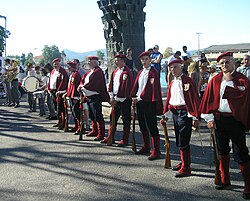 | The Feast of San Blas, Patron of Dubrovnik |
| Good. immaterial registered in 2009.
|
On the eve of the Feast of San Blas, in the afternoon, all the bells of the churches of the town of Dubrovnik (Croatia) are thrown into flight and bands of white doves, symbols of peace are released when the faithful gather to celebrate a ritual of healing of the evil throat destined to preserve them from the diseases. On February 3, the official date of the feast of the city and its patron saint, the portastats of the parishes, engalanados with folkloric dresses, come to the city and go to the central square to participate in the climax of the festivities, a procession to which bishops, ambassadors, civil authorities, invited personalities and the entire population of Duvnik come. The festival incarnates many aspects of human creativity, from the celebration of rituals to the interpretation of folkloric songs, through the representation of performing arts and the manufacture of traditional crafts, in particular the historical firearms with which it shoots in the festivities. The celebration of the ritual, which dates back to at least 1190, has reinforced the identification of the neighbors of Dubrovnik with their patron, San Blas. With the running of time the party has evolved, just like the city and the world. Each generation, according to its own ideas and needs, introduces slight modifications to the festivities to make them truly theirs. On the day of San Blas, Dubrovnik not only brings together its inhabitants, but also all those who worship tradition and respect the right of everyone to freedom and peace. (UNESCO/BPI)
|
 | March of the campers of the Kastav region in the annual carnival |
| Good. immaterial registered in 2009.
|
In the January carnival, groups of campers travel through villages scattered by the Kastav region, north-west of Croatia. Dressed with lamb skins and touched with characteristic hats adorned with green branches, the cloaks tuck with their waistbands in groups of two to thirty, following the steps of a guide carrying a perennial leaf tree. They encourage their march by rhythmically moving their hips against each other and giving breezes to the air. The groups sometimes include Buddha characters, like a naughty “bearer” who systematically mocks the surveillance of their two “guardians”. When they arrive in a village, the chambers are grouped in concentric circles in the square of the town, playing their bells until the neighbors give them food and shelter before following their journey. At the end of the carnival, the campers return to their respective villages and collect the trash from all the houses, burning them in front of them. All present attend this ritual. The annual carnival champions’ party, which presents characteristic variants in each village, contributes to the narrowing of the links of the communities and is an excellent means of renewing the friendly ties between the peoples of the region and integrating the newcomers into the traditional culture of the region. (UNESCO/BPI)
|
 | The procession of spring of the Ljelje/Kraljice (reinas) of Gorjani |
| Good. immaterial registered in 2009.
|
The Queens Procession is celebrated every year by spring and is attended by young people from the village of Gorjani, located in the Slavonia region, northeast of Croatia. Each set of the procession consists of two groups: one of ten girls, touched with hats of man and armed with sables, representing the kraljevi (reyes); and another of ten young men, crowned with white garlands such as brides, who personify the kraljice (reins). On the day of the Christian feast of Pentecost, the girls go in court of house at home and interpret their songs and dances to each family. As kings perform their dance of the saber, the queens comment their movements with songs. Then the family visited joins the young and performs a folk dance in union. After having given the girls a refreshment, they go in court to another house. The next day the procession goes to a neighboring city or village to follow the rejoicing, culminating in a party at the home of one of the young. The whole town – the primary school, the parish and numerous families – contributes to the preparations for the procession and the young people who have participated in it feel particularly proud. Although it is not known to certain what the meaning and origin of this ritual are, what is true is that the inhabitants of Gorjani consider it a symbol of their people and an occasion to show the beauty and elegance of their daughters. (UNESCO/BPI)
|
 | The procession Za Krizen (via crucis) on the island of Hvar |
| Good. immaterial registered in 2009.
|
After the Holy Thursday Mass, before the Christian feast of the Easter of Resurrection, each of the six villages of the Dalmatian island of Hvar, located south of Croatia, designate a group of neighbors to go in procession to the remaining five villages and return to their starting point, making a journey of twenty-five kilometres in eight hours. Each of the groups of this way of crucis organized by the communities is headed by a bearer of the cross, who walks without rest with bare feet or socks. Formerly, that carrier was chosen among the members of religious fellowships, but today it is chosen from a list of registered candidates at times twenty years in advance. His function, ambitious and respected, illustrates the degree of devotion of this person and of his entire family. Behind the bearer of the cross are two companions with each other's candelabras, other people with candlesticks and lighthouses, five corists who tune in the mourning of the Virgin Mary at various points of the journey and many faithful of all ages, Croatian or foreign, who wear habits of various religious fellowships. Having been received by each of the priests of the other five peoples, the processions return to their respective starting points. The bearers of the cross travel to the race the last hundred meters of the itinerary to receive the blessing of the parish priest of his people. The ancestral and inalienable element of the cultural and religious identity of Hvar, this procession constitutes a link between the islanders and the world Catholic community. (UNESCO/BPI)
|
 | Sinjska Alka, Sinj cavalry tournament |
| Good. immaterial registered in 2010.
|
Sinjska Alka is a cavalry tournament that is held every year, since the 18th century, in the city of Sinj, located in the region of Cetinska Krajina. The riders who participate in this competition ride every gallop on one of the main streets of the city, pointing with their spear an iron ring suspended from a rope. The name of the tournament comes from the word alka (anillo), which is of Turkish origin and reveals the historical coexistence of two different civilizations, as well as the cultural exchanges between them. The rules of the tournament, codified in a regulation dating from 1833, preconceive ethical conduct and fair play, while stressing the importance of participation in the life of the community. Participants have to be members of families in the city of Sinj and the region of Cetinska Krajina. The community as a whole takes part in the manufacture, preservation, restoration and repair of weapons, clothing and accessories used in this traditional festivities, in order to contribute to their durability. Parallel to the tournament there are religious celebrations, social gatherings, family visits and various rejoicing, both at home and outdoors. Sinjska Alka is the only remnant of the ancient medieval tournaments that were held regularly in the coastal cities of Croatia until the nineteenth century. It has become a remarkable event in local history and a means of transmitting the collective memory of one generation to another. (UNESCO/BPI)
|
 | The development of spice bread in northern Croatia |
| Good. immaterial registered in 2010.
|
The tradition of the elaboration of the spice bread arose in some European monasteries in the medieval period and extended to Croatia, where it became an artisanal activity. The artisans who made this bread, settled in the north of the country, were also engaged in the manufacture of candles and honey. The process of making spices bread requires skill and speed at the same time. The recipe used by all artisans is the same: they make a dough with flour, water, sugar and sodium bicarbonate and add the essential spices. The dough is placed in moulds, cooked, dried and painted with food dyes. Each artisan adorns the bread to his stew, with images, mirages, verses and messages. The most common thing is to give it the form of a heart and to prepare for weddings, ornamented with the names of the newlyweds and the date of the marriage. Each craftsman exercises his trade in a given area, without his activity interfering with that of others. The technique of making bread has been transmitted from generation to generation from many centuries ago, in the beginning only between men, but today women are also depositors of this tradition. Over time, spice bread has become one of the most notorious symbols of Croatian identity. Currently, the craftsmen who manufacture it are among the most important participants in all types of parties, events and local meetings, and their presence gives local populations a sense of identity and continuity. (UNESCO/BPI)
|
 | The ojkanje song |
| Good. immaterial registered in 2010 on the Intangible Cultural Heritage List that requires urgent safeguard measures.
|
The ojkanje singing with two voices, whose practice is extended by the districts of the interior of the Dalmatian region of the Republic of Croatia, is interpreted by two or more singers (men or women) with a peculiar vibration of the voice produced with the throat. The singing lasts as long as the one that can hold the lead singer without breathing. The tonal scales of the melodies are limited and essentially chromatic, and their lyrics cover very diverse themes, from love to current political and social issues. The Oskanje song has survived thanks to organized groups of local depositaries of this traditional art, which continue to transmit their knowledge and techniques and represent their peoples of origin at festivals in Croatia and other countries of the world. Although the ojkanje singing is usually transmitted orally, the audiovisual media and the learning organized within local folk groups are playing an increasingly important role in their transmission. However, the survival of the techniques of individual vibrate and of numerous forms of chanting to two voices depends, to a large extent, on the existence of talented interpreters and competition who are able to apply their knowledge and transmit them to younger generations. To the conflicts of the recent past and the emigration of the rural population to the cities, which have led to a decline in the number of inhabitants of the region, the evolution of the way of life has been added. All this has brought with it a sharp decrease in the number of interpreters and the disappearance of many genres and old styles of chanting alone. (UNESCO/BPI)
|
 | The practice of chanting and bećarac music of Eastern Croatia |
| Good. immaterial registered in 2011.
|
Bećarac music is a popular artistic genre in eastern Croatia, deeply rooted in the cultures of Slavonia, Baranja and Syrmia. The communication between their interpreters is essential: the soloists exchange their melodic lines and try to overcome others, accompanied by a choir and tambuic bands. This music is not only a vector of the values of the community, but it allows its performers to express thoughts and feelings that could be inappropriate if expressed directly or in other contexts. Each soloist modulates its interpretation according to the context, and the representation lasts as long as the energy and creativity of the singers allow it. The soloists have to be endowed with a powerful voice, they must know an extensive repertoire of ancient and new distics, and must possess a great capacity, speed and ability to choose and combine them. Today, the number of women and men depositaries of this musical tradition is practically the same. Bećarac music is widespread among the communities of eastern Croatia and is still a living social practice, both in informal contexts of musical interpretation and in the context of the current festivities and celebrations. In addition to the musical peculiarities provided by the soloists, there are numerous bećarac subtypes. This musical genre is not only extraordinarily alive and dynamic, but also renewed in every show. (UNESCO/BPI)
|
 | The Nijemo Kolo, silent dance of the interior of Dalmatia |
| Good. immaterial registered in 2011.
|
Bećarac music is a popular artistic genre in eastern Croatia, deeply rooted in the cultures of Slavonia, Baranja and Syrmia. The communication between their interpreters is essential: the soloists exchange their melodic lines and try to overcome others, accompanied by a choir and tambuic bands. This music is not only a vector of the values of the community, but it allows its performers to express thoughts and feelings that could be inappropriate if expressed directly or in other contexts. Each soloist modulates its interpretation according to the context, and the representation lasts as long as the energy and creativity of the singers allow it. The soloists have to be endowed with a powerful voice, they must know an extensive repertoire of ancient and new distics, and must possess a great capacity, speed and ability to choose and combine them. Today, the number of women and men depositaries of this musical tradition is practically the same. Bećarac music is widespread among the communities of eastern Croatia and is still a living social practice, both in informal contexts of musical interpretation and in the context of the current festivities and celebrations. In addition to the musical peculiarities provided by the soloists, there are numerous bećarac subtypes. This musical genre is not only extraordinarily alive and dynamic, but also renewed in every show. (UNESCO/BPI)
|
 | Klapa: chanting several voices of Dalmatia (Southern Croatia) |
| Good. immaterial registered in 2012.
|
Klapa vocal music is a traditional song to various voices practiced in the Dalmatia region (Southern Croatia). It is characterized mainly because it is homophonic, it is interpreted to cappella, it is composed in a simple way and is transmitted by oral tradition. The head of each group of singers is the first tenor and is seconded by other tenors, baritonos and bass. During interpretation, the singers form a tight semicircle. It's the first tenor who breaks out and the others follow him. The purpose is to get the best possible mix of voices. From a technical point of view, the interpreters of the vocal music klapa express their humors with open singing, gutural, sotto voce, or in falsete, usually in an elevated tesitura. Another characteristic of this music is that you can sing freely, without notation. The themes of the klapa songs are usually love, the chances of life and the local environment. The depositaries of this art and their interpreters are amateurs of talent, heirs of the tradition of their predecessors. Their age varies, as many young people sing with older interpreters. In the field of the “traditional” klapa, the transmission of knowledge is performed orally, while in the klapa “of festival” that transfer is organized more formally and focuses on the realization of concerts and presentations. In the field of “modern” klapa, singers are gaining experience with attending concerts and listening to sound recordings. Local communities consider that this traditional song is a central element of their musical identity that integrates respect for diversity, creativity and communication. (UNESCO/BPI)
|
 | The Mediterranean Diet |
| Good. immaterial registered in 2010, expanded in 2013.
|
This element is shared with Cyprus Cyprus, Spain Cyprus, Spain Spain, Greece Spain, Greece Greece, Italy Greece, Italy Italy, Morocco Italy, Morocco Morocco and Morocco and  Portugal Portugal |
The Mediterranean diet includes a range of knowledge, practical skills, rituals, traditions and symbols related to agricultural crops and crops, fishing and animal breeding, as well as ways of preserving, transforming, cooking, sharing and consuming food. The act of eating together is one of the foundations of the cultural identity and continuity of the communities of the Mediterranean basin. It is a moment of social exchange and communication, and also of affirmation and renewal of the ties that make up the identity of the family, the group or the community. This element of immaterial cultural heritage highlights the values of hospitality, good-neighbourliness, intercultural dialogue and creativity, as well as a way of life that is guided by respect for diversity. It also plays an essential role in social cohesion in cultural spaces, celebrations and celebrations, by bringing together people of all ages, conditions and social classes. It also covers areas such as handicrafts and the manufacture of containers for food transport, conservation and consumption, such as ceramic dishes and glasses. Women play a key role in transmitting the skills and knowledge related to the Mediterranean diet, safeguarding culinary techniques, respecting seasonal rhythms, observing the calendar holidays and transmitting the values of this element of cultural heritage to new generations. For their part, local food markets also play a key role as cultural spaces and places of transmission of the Mediterranean diet in which the daily practice of exchanges fosters concord and mutual respect. (UNESCO/BPI)
|
 | Knowledge and techniques of the art of building walls in dry stone |
| Good. immaterial registered in 2018.
|
This element is shared with Slovenia Slovenia, Cyprus Slovenia, Cyprus Cyprus, Cyprus,  France, Greece France, Greece Greece, Spain Greece, Spain Spain, Italy Spain, Italy Italy, Switzerland Italy, Switzerland Switzerland Switzerland |
The art of building dry stone walls includes knowledge and practices about its realization with a mere stacking of stones without using other construction materials, except land also dry on some occasions. These walls are widespread in and outside the areas inhabited in most rural regions, mainly in steep terrain, although they can also be found in some urban regions. Its structural stability is obtained thanks to a highly careful selection and placement of the stones. These walls have created different types of human habitats, as well as structures for agriculture and livestock, which have shaped very numerous and varied landscapes. These constructions are a testimony to the methods and practices used by the populations from prehistory to the modern era, with a view to organizing their living and work spaces, making the most of the local natural and human resources. The dry stone walls play an essential role in the prevention of landslides, floods and avalanches, in the fight against erosion and desertification of land, in the improvement of biodiversity and in the creation of micro-climatic conditions conducive to agriculture. The depositaries and practitioners of this element of cultural heritage are the rural communities in which it is deeply rooted, as well as the professionals of the construction sector. Dry stone structures are always performed in perfect harmony with the environment and the techniques used are an example of a balanced relationship between human beings and nature. The transmission of this art of construction is carried out mainly through the practice adapted to the specific conditions of each place. (UNESCO/BPI)
|
 | Međimurska popevka, folkloric vocal music of the region of Međimurje |
| Good. immaterial registered in 2018.
|
Folk vocal music from the north-eastern Croatian region of Međimurje, the “međimurska popevka” was in the past an artistic genre practiced mainly in women alone. Today it is interpreted by both men and women, in group or individually. One or more voices are sung by instruments or without them, and can also be interpreted as an exclusively instrumental piece or for the accompaniment of dances. The themes of the lyrics of the “popevkas” are of considerable importance, since according to them these songs are classified into loving, nostalgic, sad, humorous and religious. The most active depositaries of this element of cultural heritage are fundamentally members of very old cultural and artistic societies and associations, but soloist singers also play an important role in this area because the typicality of the “popevka” is in an interpretation full of individualized nuances. This vocal music is practiced in private, alone, and on the occasion of numerous social events held in or outside the Međimurje region: family meetings, community or professional parties, religious ceremonies and artistic representations. Most of the inhabitants of the region hear and learn “popevkas” throughout their lives on multiple occasions, and often come or are invited to take part in their composition and interpretation, as well as in representations. Today, there are about fifty singers who master this art and possess the capacity to transmit the classic elements of it, enriched with their own personal expressions. Women often play the role of guardians in transmitting this musical practice to new generations. (UNESCO/BPI)
|
 | Traditions of breeding of the lipizzanos horses |
| Good. immaterial registered in 2022.
|
This element is shared with Slovenia Slovenia, Bosnia and Herzegovina Slovenia, Bosnia and Herzegovina Bosnia and Herzegovina, Slovakia Bosnia and Herzegovina, Slovakia Slovakia, Italy Slovakia, Italy Italy, Austria Italy, Austria Austria, Hungary Austria, Hungary Hungary, Romania Hungary, Romania Romania Romania |
The traditions of the lipizzanos horses were initially used to breed specimens for the imperial court of the Habsburgs in Vienna, but today the lipizzano horse plays a special role in the daily cultural and social life of the rural communities. They are included in events, celebrations and holidays such as horse blessings, carnival processions and parades. Horses also play a key role in therapeutic horseback riding and sustainable tourism. The people who work in the state cattle ranches represent the main carriers of the element, along with the therapists, the artisans, the equestrian sports groups, the traditional military, the local communities and the visitors of the ranches. Values, knowledge, skills and practices are transmitted through experiences, seminars and training sessions, as well as during festive and sporting events. The practice is also part of the curricula of some local primary schools and all agricultural and vocational schools and agricultural and veterinary universities. The breeding of lipizzanos horses has joined the communities for more than 450 years, generating a strong sense of shared identity, even through its specialized vocabulary and the close emotional connection between breeders and horses. (UNESCO/BPI)
|
 | The Feast of Saint Triphon and Kolo (dance in corro), traditions of the Croats of Boka Kotorska (Bahía de Kotor) living in the Republic of Croatia |
| Good. immaterial registered in 2022.
|
The celebrations of San Trifón and the Kolo (baile en corro) of San Trifón revolve around two main annual events: the Feast of San Trifón (3 February) and the Nights of Boka. The kolo, played by members of the Boka Marina tied with their traditional uniforms, is the most visible cultural element of the event. The carriers of this tradition meet throughout the months of February and March in each of the cities in which the Navy of Boka is present. These meetings, called the Boka Nights, present the cultural heritage of the Croats of Boka to the Croatian public. The celebrations are related to the worship of San Triphon. His relics were taken to Kotor in 809. Since then, the saint is venerated as the patron of Kotor, the Diocese of Kotor and the Navy of Boka. Community members participate in the preparation and maintenance of uniforms and are interested in typical Boka recipes. The knowledge of the general cultural and historical background of the Boka Croats and their patron saint is also transmitted through exhibitions, public conferences, cultural evenings and other events. (UNESCO/BPI)
|




















